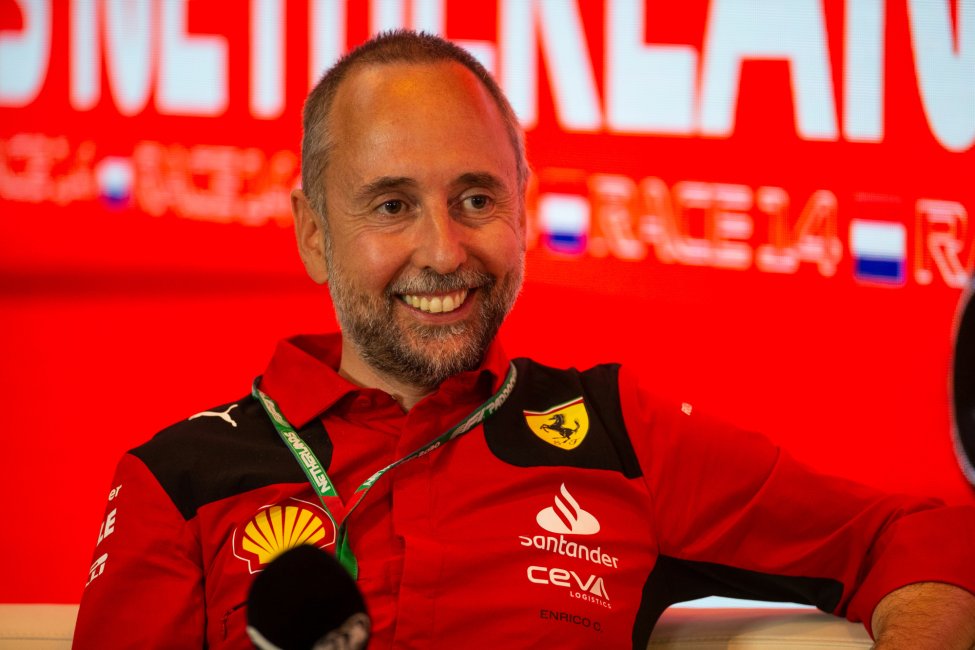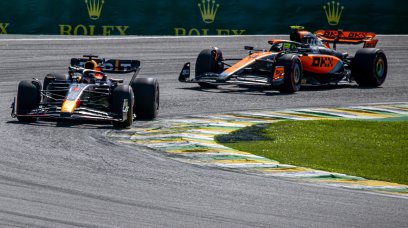When Ferrari put an end to Red Bull's dominant run of victories in Singapore, it was the result of gradually chipping away at their advantage with a clear development plan in 2023.
The weaknesses of the SF-23 were already apparent during the pre-season tests in Bahrain, prompting the Scuderia's engineers to opt for a change of direction of the aerodynamic concept.
The engineers realised the structural limitations of the project linked to the chassis, or rather, the position of the lateral crushable structures (anti-intrusion cones), radiators and electronic control units, and the dimensions of the gearbox which had limited the diffuser design.
Led by Enrico Cardile under the supervision of Diego Tondi, the objective of the aerodynamic engineers was to obtain a more stable dynamic and aerodynamic balance, and for a drastic reduction in tyre degradation. These exposed the underlying inconsistency of the car's performance in the race, compared to the performance shown in qualifying.
Exposing the underlying weaknesses
This objective was only achieved in the final part of the season at the Dutch Grand Prix. This represented the turning point in understanding the dynamic and aerodynamic behaviour of the SF-23, and led to both Carlos Sainz and Charles Leclerc getting as close as anyone to ending Red Bull's win streak at the following race in Italy.
From that moment, in defining the setup for each grand prix, it was decided to sacrifice the maximum downforce and opting for a better aerodynamic balance, with the adoption of particularly low ride heights.
The floor of the car has progressively constituted a preview of the concepts integral to the 2024 single-seater. As described, even the lower part of the SF-23 was strongly limited by the architecture, by the packaging of the accessories.
As a consequence, this prevented the development of sections of the Venturi channels, but above all the increase in the effectiveness of the diffuser which would have allowed greater downforce values to be obtained.
This enabled greater stability in the high speed corners, something that both drivers complained about as being 'peaky' during the season.
Viewed by others:
Defining a concept
By mid-December the first chassis of the new single-seater had already been built and all the components were being assembled - ahead of a very tight schedule.
There are two directions followed by aerodynamicists in defining the new car concept; one concerns the increase in the flow rate and quality of the air flow that touches the lower section of the sidepods. The increase in the section of the channel that develops between the floor and the sidepods is essential to bring a greater flow and quality towards the rear.
As described, last year the structural limit that prevented the realization of a similar concept was the presence of lateral anti-intrusion cones halfway up the chassis.
For this reason the chassis in the 676 project has been completely redesigned, not only by placing these elements at the lower limit of the chassis, but also by repositioning the radiators and adopting a more advanced position on the sidepods compared to the 2023 for electronics control units.
The second intervention, no less important nor less radical, concerns the total redesign of the gearbox to gain approximately 40mm in width with a redesigned pull rod rear axle.
The central section of the floor, which extends to the center of the diffuser on the 676, will be decidedly narrower. This frees airflow in favour of an increase not only in the effectiveness of its extraction, but also in the efficiency of the rear wing - specifically at the lower profile level (beam wing).
Exploiting the low ride heights
Last but not least, as mentioned above, the intervention linked to the geometry of the suspension. Rumours over the course of last season pointed to the 2024 Ferrari suspension being similar to that of Red Bull, i.e. adopting the front pull rod and rear push rod scheme.
In reality the layouts will remain those of the SF-23, but the geometries, i.e. the relative positioning of the various elements, will be different. Specifically, at the front suspension, the upper triangle will be characterised by a strong inclination of the arms, thus guaranteeing an accentuated anti-dive (anti-sinking) effect on the front end.
The high inclination of the arms of the upper triangle will have an aerodynamic value by increasing the down wash (downward deviation) of the air flow directed towards the channel between the sidepods and the floor. These features were taken to the extreme on the world champion RB19, constituting a focal point for the management and reduction of longitudinal downforce transfers.
Above all, the revision of the rear suspension is considered fundamental for the competitiveness of the new single-seater. The (logical) choice of traveling with reduced ride heights, can be effective only on condition that porpoising is marginal.
The 'bottoming' effect that is generated by the sinking of the rear axle in a straight line at full speed, can cause a strong, non-linear increase in the aerodynamic load - the main cause of aero-elastic jolts (porpoising).
Given this assumption, the engineers directed by Cardile worked hard on redefining the rear suspension and the floor attachments of the 676. This eliminated the bumps induced at an aerodynamic level and therefore, in theory thus allowing the constant adoption of a set-up on every type of track close to the ground.
In addition, despite being frozen in performance development, the power unit will adopt modes. Partially already implemented in the second part of 2023, these will feature less abrupt delivery of electric power during acceleration to the further reduce tyre degradation.
Clutch management strategies, specifically in the starting phase, will be adapted more effectively to this parameter than in 2023. In short, Vasseur did not want to define the 2024 single-seater as revolutionary, but it is undeniable that the cut with the recent past will be clear.
Project 676 in detail
Front View
Note the reduced lower section of the sidepods, especially in the lower section with the anti-intrusion cones incorporated at the level of thefloor. Highlighted in detail, the high inclination of the upper suspension triangle to accentuate the ANTI DIVE effect. A further feature will concern the minimum vertical cross section of the cooling air intakes which could have a decidedly Red Bull-inspired profile, or keep a more elongated section.
SF-23 side view
At its debut, the SF-23 was characterized by long sidepods with a concave/tub upper profile. This determined a clear separation between the flow that lapped above them extracting the heat from the vertical slits arranged in an S configuration and the flow passing between the lower profile of the sidepods and the floor.
SF-23 development Austria
In Austria, after the introduction in Spain of the new configuration with sloping sides, the engineers directed by Tondi had tried to increase the width of the channel between the sidepods and the floor, clashing with the insurmountable limit represented by the anti-intrusion cones (see detail).
SF-23 setup with reduced ride heights in the final phase of the season
In the last part of the season, the SF-23 adopted minimum ride heights even on non-permanent tracks as in the case of Singapore and Las Vegas, where the common tendency among the other teams was to increase them. It was sign of the improved balance of the car, which has become less prone to aero-elastic jolts (porpoising).
Don't miss out on any of the Formula 1 action thanks to this handy 2026 F1 calendar that can be easily loaded into your smartphone or PC.
Download the calenderMost read














Join the conversation!